“Joel, this is Marty. I’m calling you from a cell phone — a real, handheld, portable cell phone!”
These were the first words uttered into a cell phone.
Stuttering into his prototype in 1973, Motorola Engineer Martin Cooper secured his position as the father of cellphone technology.
Then came a decade-long hiatus until, at last, the first commercially-available cell phone arrived on shelves in 1983. Over the next 35 years, cell phone development ran riot.
From bulky, cumbersome, suitcase-like devices, cell phone design has morphed into sleek, streamlined personal assistants that can anticipate your every move, deliver a library of information, and connect you with anyone in the world.
Wondering what that journey looked like?
In this cell phone timeline, we’ll give you the complete visual evolution of cell phone design from 1983 to 2020.
Table of Contents
- Cell Phone Timeline #1: Motorola DynaTAC 8000X – 1983
- Cell Phone Timeline #2: Nokia Talkman – 1984
- Cell Phone Timeline #3: Motorola MicroTAC 9800X – 1989
- Cell Phone Timeline #4: Nokia 1011 – 1991
- Cell Phone Timeline #5: Motorola International 3200 – 1991
- Cell Phone Timeline #6: IBM Simon – 1994
- Cell Phone Timeline #7: Nokia 2110 – 1994
- Cell Phone Timeline #8: Nokia RinGo – 1995
- Cell Phone Timeline #9: Nokia 8110 – 1996
- Cell Phone Timeline #10: Nokia 9000 Communicator – 1996
- Cell Phone Timeline #11: Nokia 9110 – 1998
- Cell Phone Timeline #12: Siemens C25 – 1999
- Cell Phone Timeline #13: Nokia 3210 – 1999
- Cell Phone Timeline #14: Nokia 8210 – 1999
- Cell Phone Timeline #15: BlackBerry 850 – 1999
- Cell Phone Timeline #16: Nokia 5210 – 1999
- Cell Phone Timeline #17: Samsung SPH-M100 – 2000
- Cell Phone Timeline #18: Nokia 3310 – 2000
- Cell Phone Timeline #19: Ericsson R380 – 2000
- Cell Phone Timeline #20: Sony Ericsson T68 – 2001
- Cell Phone Timeline #21: Nokia 5510 – 2001
- Cell Phone Timeline #22: Siemens S45i – 2001
- Cell Phone Timeline #23: Nokia 7650 – 2002
- Cell Phone Timeline #24: Sanyo SCP-5300 – 2002
- Cell Phone Timeline #25: HTC Universal – 2005
- Cell Phone Timeline #26: Motorola Q – 2006
- Cell Phone Timeline #27: iPhone (1st Generation) – 2007
- Cell Phone Timeline #28: iPhone 3G – 2008
- Cell Phone Timeline #29: Samsung Instinct – 2008
- Cell Phone Timeline #30: Google Nexus One – 2010
- Cell Phone Timeline #31: iPhone 5 – 2012
- Cell Phone Timeline #32: Samsung Note 4 – 2014
- Cell Phone Timeline #33: BlackBerry KeyOne – 2017
- Cell Phone Timeline #34: Samsung Galaxy Fold – 2019
- Cell Phone Timeline #35: iPhone 11 – 2020
- Conclusion
Cell Phone Timeline #1: Motorola DynaTAC 8000X – 1983

The Motorola DynaTAC 8000X was the first commercial portable cellular phone. The model received approval from the U.S. FCC on September 21 1983, and was released for sale the following year.
Six times heavier and twice as long as the iPhone 6, this pricey mobile device cost $3,995 in 1984 (over $9,000 today).
Cell Phone Timeline #2: Nokia Talkman – 1984

Nokia jumped on the cell phone bandwagon early, having previously developed car phones. Known as Nokia-Mobira back then, the Finnish brand’s first model sold extremely well in Europe.
Paying attention to cell phone design, notice the bulky detachable battery and the carry handle for this hefty device.
This briefcase-like phone cost the equivalent of $5,800.
Cell Phone Timeline #3: Motorola MicroTAC 9800X – 1989

Cell phone design trends quickly transitioned away from heaviness, catching on to the benefits of being light.
Motorola’s MicroTAC was the answer in 1989.
As well as being the world’s first flip phone, the MicroTAC’s drastically smaller design revolutionized cell phone design.
Securing Motorola’s commitment to analog technology, this lightweight cell phone cost around $6000 in today’s money.
Cell Phone Timeline #4: Nokia 1011 – 1991

Welcoming the world’s first GSM cell phone, the 1011 was Nokia’s response to smaller cell phone design.
Gone are the handle and colossal battery, replaced by an extendable antenna and cutting-edge monochrome LCD screen.
This model can store 99 phone numbers, but while claims say it was the first SMS-enabled phone, this isn’t true.
Cell Phone Timeline #5: Motorola International 3200 – 1991

Taking what appears to be a backward step, Motorola released the International 3200 in 1991.
Favoring the brick-sized cell phone design, this phone had a fixed aerial but a more slim-lined body than earlier models. In Germany, people called it a ‘knochen’ because of its likeness to a bone.
Interestingly, the battery took 5 hours to charge!
Cell Phone Timeline #6: IBM Simon – 1994
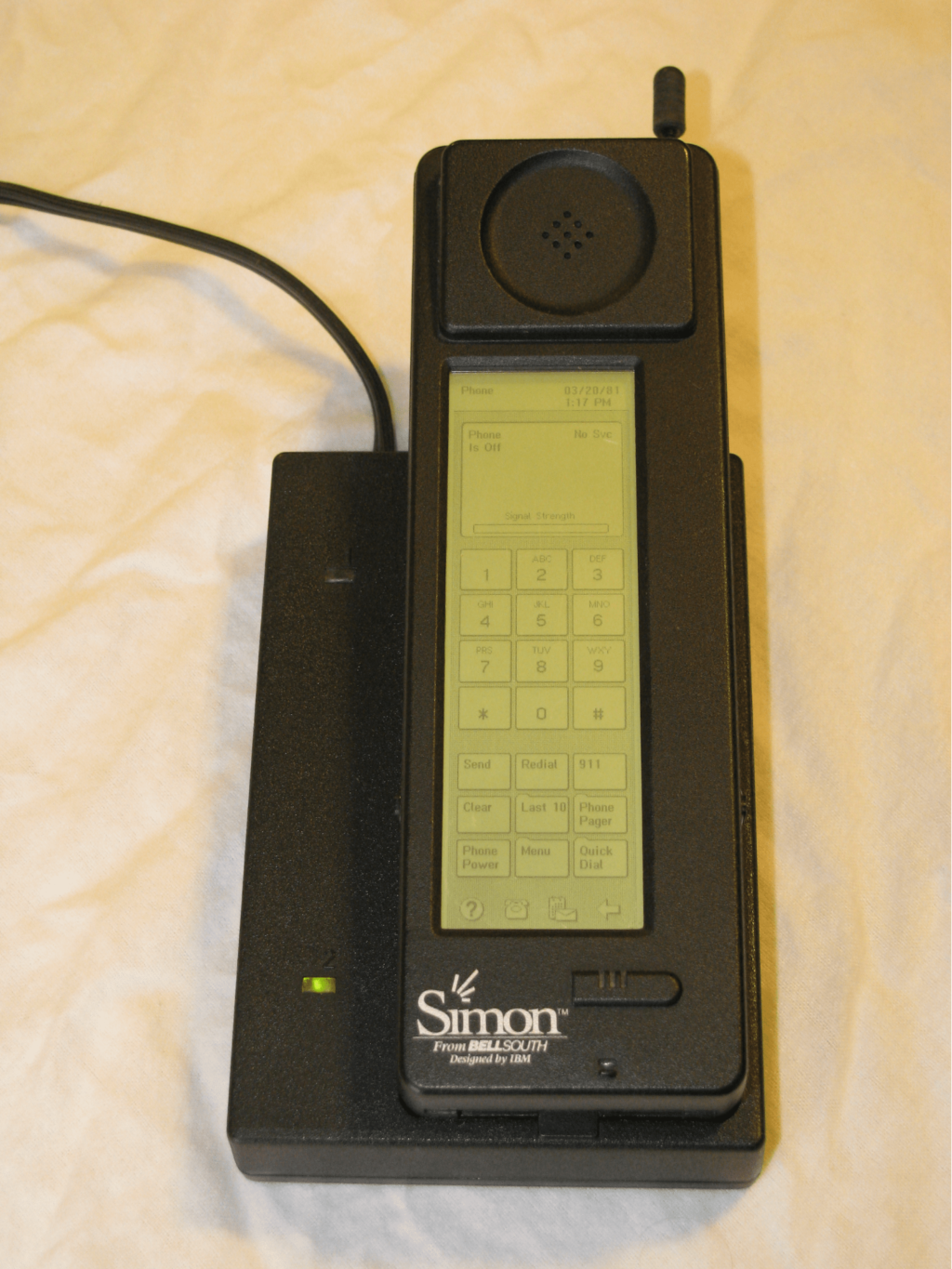
While we may think smartphones are new, IBM’s Simon was the first all the way back in 1994.
This personal communicator was the first handheld, touchscreen, personal digital assistant with telephony capabilities.
Preloaded with apps like Mail, Sketch Pad, and To Do, this model cost the same as a top smartphone today — $2000 ($1100 in 1994).
Weighing just over a pound, this 8-inch smartphone was an inch and a half thick!
Cell Phone Timeline #7: Nokia 2110 – 1994
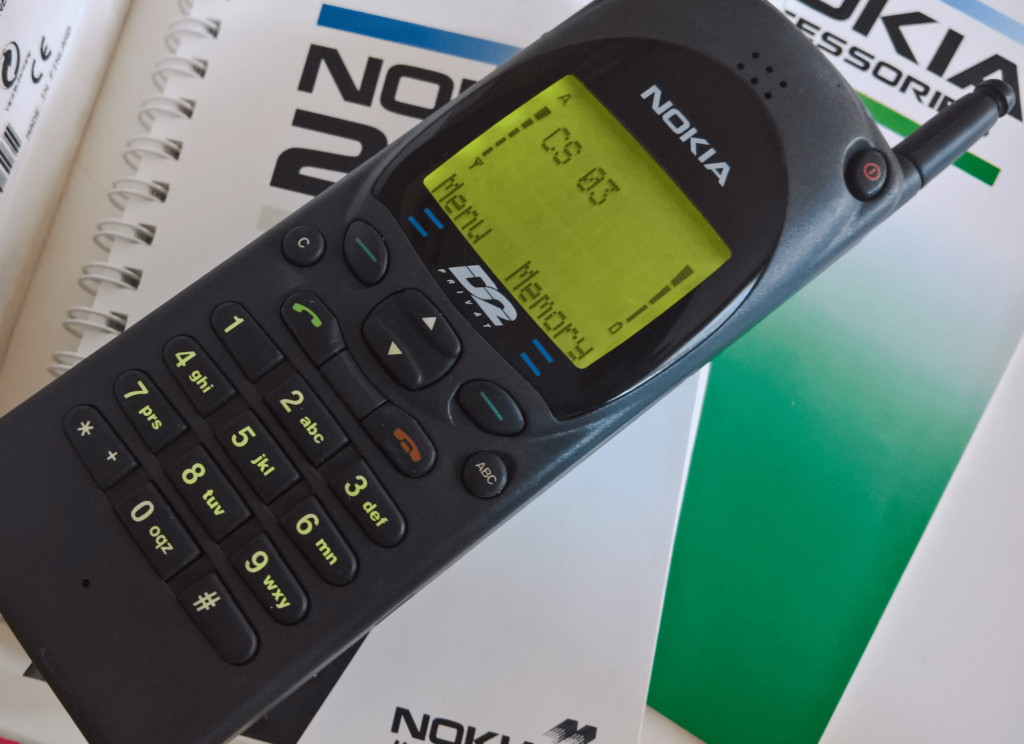
Significantly smaller than Nokia’s previous models, the 2110 had a minimal aerial and a notably larger LCD display.
This model sits in the first SMS generation of phones. Users repeatedly tap the soft buttons to access the letters for text messages.
The 2110 was also the first Nokia featuring the iconic ringtone.
Cell Phone Timeline #8: Nokia RinGo – 1995

The Nokia RinGo’s bright blue phone case introduced the concept of a phone personalization and accessorization.
This model played with button placement; a concept repeated throughout the 1990’s mobile phone design.
The RinGo featured a screen upgrade, offering users the choice of a grey or green monochrome LCD screen.
This phone design quickly gained a reputation as a “girl’s phone.” It even got the nickname ‘bimbo phone’ in Sweden!
Cell Phone Timeline #9: Nokia 8110 – 1996
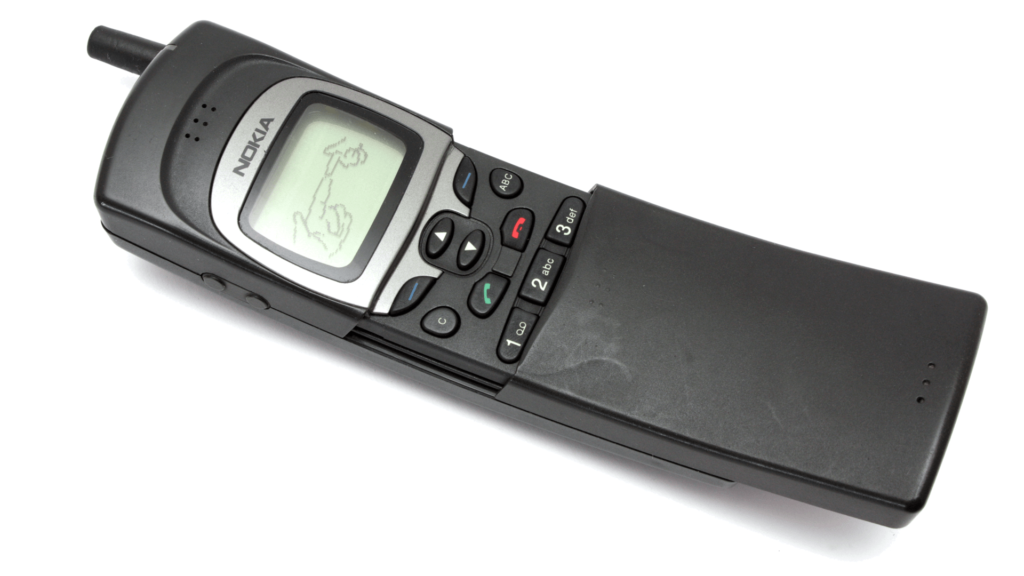
The Nokia 8110 was the first phone with a slide cover for the buttons.
Targeting the business market, this model was the smallest, lightest phone yet, weighing only 152 grams.
While this slide phone gained kudos for being used by Neo (Keanu Reeves) in the original Matrix movie, its curved design earned it the moniker ‘banana phone’.
Cell Phone Timeline #10: Nokia 9000 Communicator – 1996
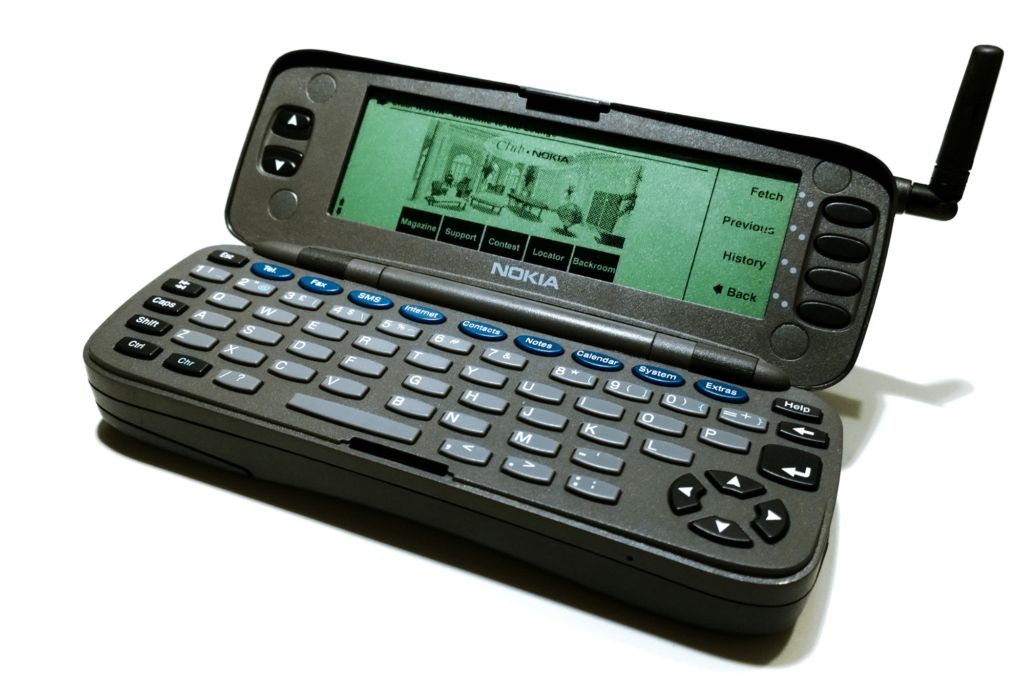
Another early smartphone, the Nokia Communicator 9000 was released in 1994. This hybrid model consisted of a palmtop computer cradled in a Nokia 2110 mobile phone.
Able to send email and fax, the Communicator 9000 had a web browser and business apps.
Costing the equivalent of $1400 today, this handheld telephonic PC weighed over 300 grams.
Cell Phone Timeline #11: Nokia 9110 – 1998

Two years later, Nokia upgraded the Communicator 9000 to the 9110.
The sleek shape was indicative of cell phone design in the late-90s, while the compact style reduced its weight by over a third.
Using this innovative model, users could send smart messages, connect a digital camera, and compose ringtones.
Cell Phone Timeline #12: Siemens C25 – 1999

Siemens appeared on the scene in 1999 with the C25.
While lightweight, its basic mobile phone design wasn’t revolutionary.
Users were more impressed with its long battery life, allowing 300 minutes talk time and over 160 hours on standby!
Cell Phone Timeline #13: Nokia 3210 – 1999

The recognizable Nokia shape started to evolve in 1999 with the 3210.
The 3210 was the first mass-market cell phone design with an internal antenna. While trendy at the time, this early technology hampered phone reception.
Users did enjoy the upgrade to picture messages on an LCD screen. For ringtone fans, this was the first Nokia model with the Composer software.
Cell Phone Timeline #14: Nokia 8210 – 1999

The 8210 was released in late 1999, and was a drastic reduction in size compared to its predecessor.
This slim-lined handset sat snug in the user’s palm — ideal for the 8210’s introduction to first-generation ‘Snake’.
This model featured call management and speed dial and could connect to PCs and printers with infrared.
Cell Phone Timeline #15: BlackBerry 850 – 1999

While technically an email pager, 1999 saw the first commercially-sold BlackBerry.
The BlackBerry 850 upturned cell phone design with its QWERTY keyboard and thumb wheel for scrolling.
Demand exploded due to the keypad arrangement.
Cell Phone Timeline #16: Nokia 5210 – 1999
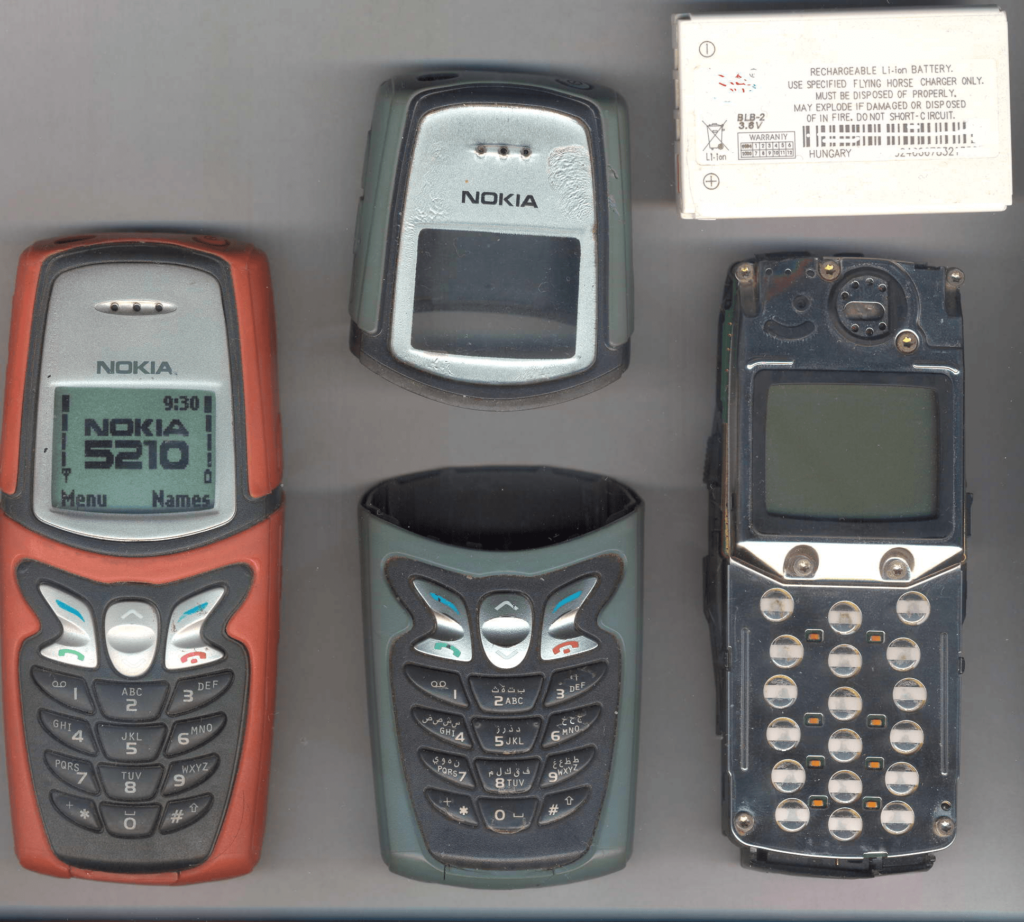
Still keeping the legendary Nokia shape, the 5210 had a removable, splash-proof, interchangeable phone case.
Not only was it known for its durability, but this model also spurred on accessorization.
This handset offered games with advanced graphics (“advanced” being a relative term, of course) enabling users to enjoy Snake II, Space Impact, Bantumi, Pairs II and Bumper.
Cell Phone Timeline #17: Samsung SPH-M100 – 2000

Welcoming Samsung on the scene, the SPH-M100 was the first cell phone design to consider music.
This handset was the first phone with mp3 capabilities. It came with high-quality headphones that neatly fit this compact device.
It’s worth noting that this phone was named by Time Magazine as one of the All-TIME 100 greatest and most influential gadgets from 1923 to 2010.
Cell Phone Timeline #18: Nokia 3310 – 2000
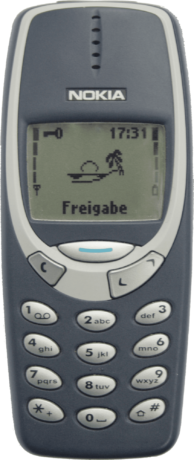
Perhaps one of Nokia’s most famous cell phone designs, the 3310 came with customizable phone cases.
The screensaver is also customizable using picture messages. Users could compose and save seven ringtones or use one of the 35 in-built ringtones.
The 3310 is jokingly known to the internet meme community for its exaggerated durability.
Cell Phone Timeline #19: Ericsson R380 – 2000

At first glance, the Ericsson’s R380 appeared to be a little behind on cell phone design trends, with its bulky design and square shape.
However, it was the first smartphone to look like a normal cell phone. The number panel flipped back to reveal a landscape screen.
This smartphone was the first Symbian OS device, and operated with a black and white touchscreen.
Cell Phone Timeline #20: Sony Ericsson T68 – 2001

The teensy Sony Ericsson T68 boasted the first color screen and came with a cover choice of two-tone grey or all-gold.
Users could enjoy color images, screensavers, and picture messages, along with feature-rich capabilities, such as Bluetooth, IrDA port, GPRS 3+1, tri-band compatibility.
This tiny model came with an add-on camera sold separately. Later upgrades integrated a camera.
Cell Phone Timeline #21: Nokia 5510 – 2001

Mixing up conventional cell phone design, the 5510 became extremely popular in the USA.
Rotating cell phone design, this phone worked in landscape, using a QWERTY keyboard split on either side of the monochrome display.
While innovative in style, the phone itself was basically a 3310 in a different outfit.
Cell Phone Timeline #22: Siemens S45i – 2001
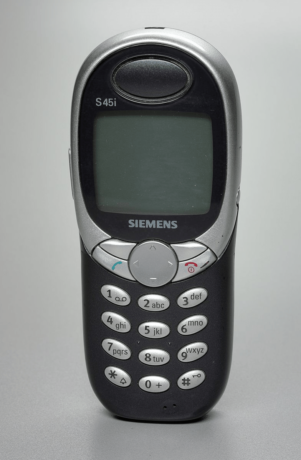
While there was nothing particularly special about the S45i design features, this non-intrusive cell phone was Siemens’ first GPRS phone.
This handset was popular due to its speedy data transmission and internet access.
Cell Phone Timeline #23: Nokia 7650 – 2002

The Nokia 7650 started to show design features of today’s smartphones, with its big screen and 2.5G capabilities.
The first Nokia featuring MMS, this model had an impressive 2.1-inch color display. However, the display wasn’t touchscreen and was still operated using buttons.
This handset was popularized after it was used in the futuristic movie, Minority Report.
Cell Phone Timeline #24: Sanyo SCP-5300 – 2002

The Sanyo SCP-5300’s clamshell style became extremely trendy following a Japanese craze.
Among the first camera phones, this flip device allowed users to view photos on the screen, instead of plugging it into a PC.
The front screen also enabled users to add photos and call recognition.
Cell Phone Timeline #25: HTC Universal – 2005

Though it looked like a mini laptop, the HTC Universal was the first 3G pocket PC phone. The model hosted Windows Mobile, and was the first-ever mobile device to use this operating system.
While significant upgrades have taken place, the HTC Universal is still sold today.
Cell Phone Timeline #26: Motorola Q – 2006
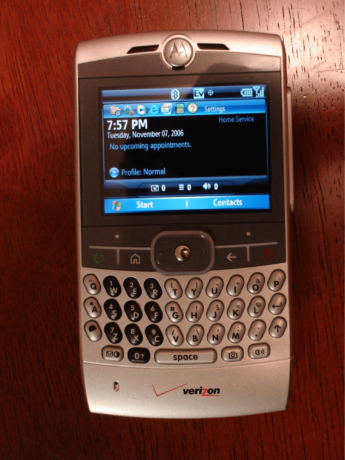
Making a comeback with a BlackBerry-inspired design, Motorola’s Q boasted a big screen and a small QWERTY keyboard, rotated on a portrait design.
This handset had a range of audio and picture formats for sending and sharing music and pictures. Users could even use the speech recognition function to text.
Cell Phone Timeline #27: iPhone (1st Generation) – 2007
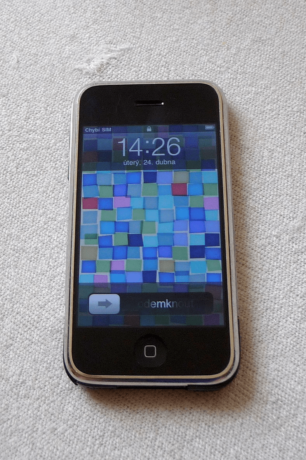
2007 saw Apple revolutionize the smartphone design with the first generation iPhone.
The full-color touchscreen epitomized Steve Job’s dedication to writing directly on the screen instead of using a stylus.
Here’s a little-known secret. The dev team codenamed this touchscreen development project ‘Project Purple 2’.
While cutting-edge in cell phone design style, critics complained about its buggy software.
Cell Phone Timeline #28: iPhone 3G – 2008

The iPhone 3G was out the next year offering a sleeker design for the second generation of Apple’s smartphone.
The iPhone 3G changed the way users interacted with smartphones by introducing the AppStore. A wealth of applications meant users could customize their experience.
While this model looked and performed better, the battery life was atrocious.
Cell Phone Timeline #29: Samsung Instinct – 2008

The Samsung versus iPhone rivalry came early on. The Samsung Instinct looked similar to an iPhone and was dubbed the ‘iPhone Killer’.
Users particularly liked the impressive 2-megapixel camera, leading to Samsung’s later reputation for good smartphone cameras.
Cell Phone Timeline #30: Google Nexus One – 2010

Designed and manufactured by HTC, the Google Nexus One was the first smartphone with Google’s Nexus software.
The cell phone design lent itself to online browsing. The wide screen made online reading easier, while the flat cell phone design and smooth edges increased comfortability.
Moving cell phone design focus to software and hardware, this handset had voice-to-text transcription and voice-guided GPS, along with an extra microphone for dynamic noise suppression.
Cell Phone Timeline #31: iPhone 5 – 2012

The iPhone 5 was the fastest-selling phone of its time.
Upgraded design features included the slimline lightning connector for quicker charging and the phone’s thinner shape and wider screen.
The iPhone 5 had an 8-megapixel rear camera and a front camera for selfies.
This model prompted patent lawsuits with Samsung.
Cell Phone Timeline #32: Samsung Note 4 – 2014

By 2004, Samsung’s signature Galaxy model was already in competition with the iPhone. The Galaxy Note 4, however, introduced the concept of wider cell phone design.
Triggering a cell phone design trend toward bigger screens, the Note 4 was considerably wider than other models. This trend is seen reflected in the wider iPhone 6 as well.
Known as a ‘phablet’, the Note 4 had damage-resistant Gorilla glass.
Cell Phone Timeline #33: BlackBerry KeyOne – 2017

BlackBerry joined the smartphone era in 2017, with the KeyOne. Contrary to the touchscreen design trend, BlackBerry famously kept buttons.
By this point, smartphones were commonly used as cameras, so storage became an important asset. This Android-based smartphone had an impressive 3GB of RAM and 32GB of internal storage.
Cell Phone Timeline #34: Samsung Galaxy Fold – 2019

Samsung has returned to the foldable phone. Instead of the retro vertical flip, the Samsung Galaxy Fold folded horizontally.
The foldable Android smartphone has a touchscreen on the outside to access the phone when folded. The device opened out to a 7.3-inch tablet.
Critics had concerns about the durability of the hinge.
Cell Phone Timeline #35: iPhone 11 – 2020

The iPhone 11 is Apple’s phone for 2020.
Featuring three cameras, users enjoy lenses for telefocus, wide angles, and super-wide angles. These cameras shot 4K video at 60 frames per second.
Faster to charge, this model claimed to have super long battery life. Users also benefit from rapid processing, as this was the first series of iPhone with the Apple A13 Bionic embedded.
Conclusion
Since the dawn of cell phone design, trends throughout the 1990s moved from bulky and big to small and compact.
However, as smartphone technology increased the capabilities of cell phones, design trends have morphed to compensate for this.
Wider displays and touchscreen features allow easier web browsing and enhanced user experience, while embedded top-spec cameras and microphones enable high-quality photos, videos, and sound.
In short, the evolution of cell phone design has replaced the clunky and the clumsy mobile designs of yesteryear with sleeker, UX-focused, usability-centric cell phone design.
 Best SEO Companies
Best SEO Companies Best SEO Companies
Best SEO Companies